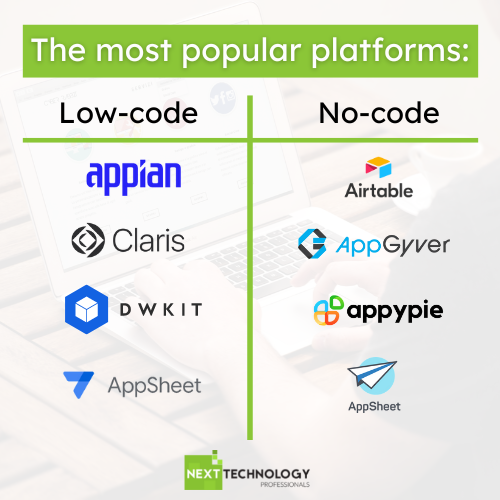Free Ideas For Selecting application development with Low-code platforms
Wiki Article
The Advantages Of Low-Code Development For Application Development In Relation To Pertains To Integration Capabilities
Low-code development of apps has numerous advantages, specifically in terms of integration. This is important for creating applications that can effortlessly connect to systems and other services. Here are the key advantages: Pre-built Connectors and APIs
A Wide Variety of Connectors. Low-code software typically includes many pre-built connections for enterprise systems that are popular (e.g. cloud services, databases, CRM). It simplifies the integration with these systems.
API Integration: Many platforms offer out-of-the box API integration features. Developers can effortlessly connect with data from other sources and services.
Easy of use:
Drag-and-Drop Integration integration tasks can usually be completed using drag-and-drop interfaces, making it possible to both developers and non-developers to set up complex integrations without writing extensive code.
Visual Workflow Creators: These visually appealing tools used to design workflows and data flows makes it easier for users to comprehend the process of integration.
Standardized Integration Methods:
SOAP/RESTful Services Support: Standard web services protocols, such as SOAP/REST allow for the easy integration of a range of different systems and applications.
OData and Other Standards Support for other standards like OData allows easy access and manipulation of data on different platforms and applications.
Real-Time Data Synchronization:
Real-Time Integrations: Low-code systems are able to handle real-time data synchronization between applications and systems, making sure that data is always up-to-date and consistent across the organization.
Event-Driven Architectures: Certain platforms offer event-driven architectures that enable applications to react in real-time whenever certain events happen, which is vital for applications that are dynamic.
Legacy System Integration:
Low-code platforms provide many tools to integrate with older systems. They let organizations modernize IT without re-designing their current systems.
Data Migration Tools Data Migration Tools: Data migration tools built-in aid in the transfer of data from old systems to the latest applications developed using low-code platforms.
Third-Party Services Integration:
Integration with Cloud Services: Seamless integration with cloud services like AWS, Azure, and Google Cloud allows for the ease of deployment and scaling applications.
Business Application Integration: Low-code platforms are able to integrate with different business software like Salesforce, SAP, Microsoft Dynamics, etc., enabling a cohesive workflow that is able to be used across various business tasks.
Simple data management:
Unified Data Modells: Some lowcode platforms provide unified coding models which simplify the management of data as well as integration and synchronization between different systems.
Data Connectors - Pre-configured connectors that provide quick access to, and manipulation of, data from various sources.
Security and compliance:
Secure Integrations - Low-code platforms have been designed to ensure that all integrations adhere to the security standards and protocols. This protects information both during its travel and when it is stored.
Compliance Features: These platforms often contain features that ensure integrations comply with the requirements of regulatory agencies (e.g., GDPR, HIPAA), providing security for companies handling sensitive data.
Extensibility:
Custom Code and Scripts: For more complicated integration requirements Low-code platforms typically allow the inclusion of custom scripts and code that allow for flexibility, without compromising ease of use.
Plug-in Ecosystems: A plugin ecosystem can be used to extend the integration capability, and allow users to expand the functionality when needed.
In the end, the integration capabilities of low-code applications development platforms makes them a powerful device for building interconnected, efficient, and scalable applications. These platforms streamline the process of connecting different IT systems, improve data flow, and help businesses adopt existing technologies, and also make use of new ones. View the top Low-code Platform for application development blog for site tips including rapid applications, driver jdbc, app dev platform, cross platform app development, app development platform, application modernization software, app modernisation, develop mobile application, rad development, rapid applications and more.

Benefits Of Low-Code Application Development In Terms Of Cost-Effectiveness
Low-code application creation offers many advantages in terms of cost-effectiveness. Businesses seeking to reduce costs can take advantage of this option while delivering quality applications. The main advantages:
Fewer Coding Requirements: Low code platforms eliminate the requirement for complex hand-coded, custom-built applications. Developers can spend less time and effort creating apps. This means lower costs for labor.
Lower Developer Resources: As low-code is quicker and easier to create, less skilled developers will be required. The cost of hiring and staffing could be significantly reduced.
Faster Time to Market
Rapid development cycle: Visual tools for development and pre-built components provided by platforms that use low-code allow rapid application development, allowing companies to get their products on the market quicker. This could result in increased revenue as well as improved positioning in the market.
Rapid Prototyping. Through the rapid creation and testing prototypes, businesses can reduce time spent on development and improve their product faster based on feedback from users.
Lower cost of maintenance:
Simpler Maintenance: Low-code platforms with their modular design and components that are standardised can be maintained more easily. The ongoing maintenance and support costs are reduced.
Automated updates: A lot of low code platforms automatically handle updates and patches, making sure that the applications are safe and current with no need for extensive manual intervention.
Efficient Resource Utilization:
Non-Developer contributions: Low code platforms enable non-developers like business users, to be a part of the development process. This democratization in development allows employees and employers to work together, thus reducing dependence on developers who earn high salaries.
Optimized Use Of IT Resources: IT teams can concentrate on strategic initiatives instead of being stymied by routine development work, improving productivity and overall efficiency.
Scalable Pricing Models
Subscription-Based Pricing: A lot of low-code platforms have flexible subscription-based pricing that scales according to use. This allows companies to match their spending to their actual needs and growth, avoiding large initial cost.
Pay-Asyou-Go Options - Some platforms allow companies to pay for only the amount they spend. This is especially beneficial for small or start-up companies with limited funds.
Reduction in Third-Party Software Costs:
Built-in Functionalities : A low-code software typically comes with built-in functions and integrations that reduce the requirement for additional third-party software, tools, and licenses.
Integrations pre-built: These pre-built systems and services are integrated with well-known services, reducing the need for custom-developed software, which saves time and money.
Increased ROI
Increased ROI: Businesses will get a better return on investment from their applications by combining rapid development, lower costs and a faster times to market.
Improved Agility: Businesses can quickly adapt to changes in the market and customer needs and ensure that they remain relevant and can capitalize on new opportunities as they arise.
The cost of training is lower:
User-Friendly Interfaces: Low code platforms are user-friendly and have simple interfaces, which decreases the learning curve.
Accessible Resources A lot of low-code platforms provide comprehensive training materials, tutorials, and support for community members, thereby reducing the requirement for formal education and the associated costs.
Collaboration is streamlined:
Improved Collaboration Tools : The collaboration tools integrated into the software facilitate collaboration and communication between team members. This results in a more efficient project development process and lower overhead.
Unified Development Environment. An unified development platform can help reduce expenses and improve workflows by reducing the complexities of managing various tools.
Overall, the cost effectiveness of software development using low-code can be attributed to its ability to reduce the cost of maintenance and development as well as increase the time to market, optimize resource use, and provide flexible price models. These elements provide substantial financial advantages to companies, making low code an attractive option for businesses who want to make the most of their budgets and create solid, reliable, high-quality applications. Check out the best Legacy application modernization with Low-code recommendations for site advice including develop web app, multiplatform mobile app development, rapid application design, develop web application, azure sql server, develop web application, app modernization, low code platforms, cross platform app dev, app dev platform and more.

Community And Support From The Vendor Are Two Benefits Of Low Code Application Development.
Low-code platform development offers significant advantages, such as support from the vendor and community. This is vital for ensuring the success of application implementation, ongoing maintenance and continuous improvement. These are the main benefits:Vendor support
Comprehensive Technical Support:
Support Teams: Several platforms using low-code have dedicated support teams to help with technical issues or troubleshooting, as well as guidance.
24/7 Support Some suppliers are available around the clock This is useful for companies operating in different time zones.
Training and Onboarding
Structured Training Programs: Many vendors provide a structured and organized training program that include tutorials, webinars and courses for certification, to help users get to speed on the platform quickly.
A lot of vendors offer personalized onboarding to help customers use the platform efficiently and tailor it to the needs of their customers.
Regular Updates and enhancements:
Continuous Improvement: Low-code platforms regularly release updates that include updates to features, security patches, and performance enhancements. This ensures that the platform will always be updated and safe.
Feedback integration: Vendors will frequently incorporate feedback from users during their development process to ensure that their platform meets the evolving demands of their users.
Comprehensive Documentation:
Documentation: A detailed documentation is offered for all products. It covers everything from the basics to the most advanced customisation. This can help users find solutions for themselves.
API References: API documentation is detailed and aids developers in integrating APIs with other platforms, as well as modify their applications.
Professional Services and Consulting
Expert Consulting. Vendors offer a wide range of services for consulting, such as the design of architecture, strategic planning and complex platform implementations. They ensure that customers get the most out of their platform.
Custom Development: Some vendors provide services that permit them to develop specific features or the features, but they aren't available in the standard version.
Community Support for the Community
Active User Communities
Discussion boards and forums Forums and discussion boards: Many platforms that are low-code feature a vibrant community for users to seek help, share solutions and collaborate in finding the most efficient methods.
User Groups and Meetups: Local and virtual user groups and meetups offer opportunities to meet, network and sharing experiences with fellow users.
Collaboration and Knowledge Sharing:
Community-Contributed Resources: Users often share templates, modules, and extensions that they have developed, which can be reused or adapted by others, accelerating development and innovation.
Crowdsourced Problem Solving: The collective knowledge and experience of the crowd can be a great resource for troubleshooting issues and figuring out creative solutions for difficult issues.
Learning and Development
Community-led training: Many groups host workshops, training sessions, and webinars. They are usually led by experienced users, who provide practical advice and advanced techniques.
Online Courses and Tutorials Community members often develop and publish online courses, tutorials, and how-to guides, enhancing the learning resources that are available to all users.
Feedback and Influence
Product Feedback Channels. Forums for community members usually have channels that allow you to provide feedback to the vendor. Feedback from customers can influence the development and improvement of new features.
Beta Testing Programs - Members of the community may be able to take part in beta testing programs. They will get an early glimpse of new features, and the opportunity to influence the evolution of the system.
Recognition and Support:
Community Recognition Programs - Many vendors have recognition programs to recognize the contributions made by active members of their communities and include MVP (Most Valuable Professionals) programs.
Peer Support : Community members offer support to other peers by sharing their experiences and providing guidance. They help create a cooperative and supportive culture by sharing their knowledge.
The overall result is solid vendor with active, engaged communities provide a comprehensive environment for support for low-code application development. The combination of robust vendor support and a vibrant, engaged community provides a comprehensive support ecosystem for low-code application development.
